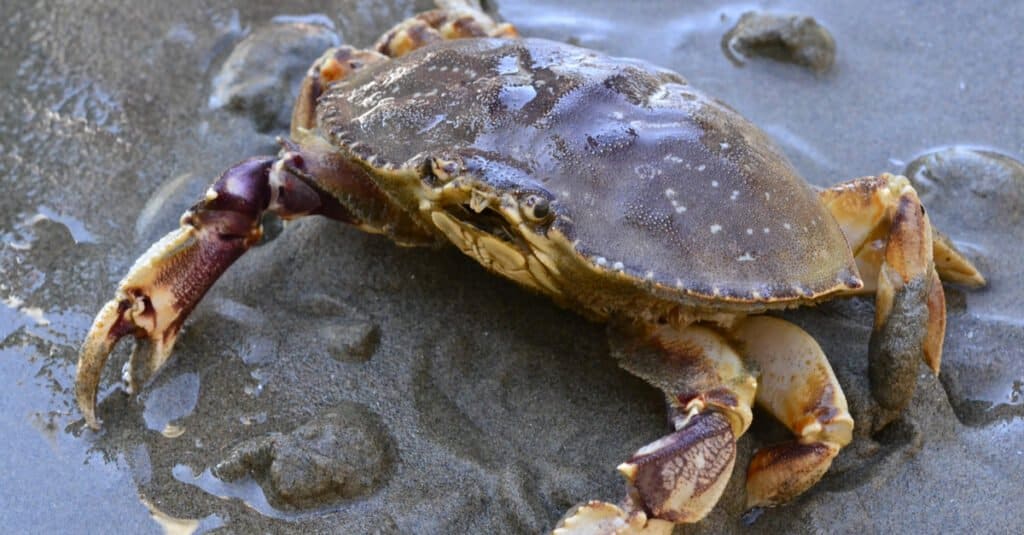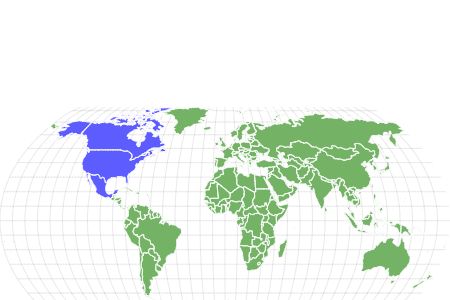Dungeness Crab
Metacarcinus magister
Advertisement
Dungeness Crab Scientific Classification
- Kingdom
- Animalia
- Phylum
- Arthropoda
- Class
- Malacostraca
- Order
- Decapoda
- Family
- Cancridae
- Genus
- Metacarcinus
- Scientific Name
- Metacarcinus magister
Read our Complete Guide to Classification of Animals.
Dungeness Crab Conservation Status
Dungeness Crab Facts
- Prey
- fish, shrimp
- Main Prey
- smaller crabs and mollusks, worms
- Name Of Young
- zoea larvae
- Group Behavior
- Solitary/Group
- Biggest Threat
- habitat damage, ocean acidification, and overfishing
- Most Distinctive Feature
- oval-shaped carapace
- Distinctive Feature
- claws with light-colored tips
- Temperament
- Solitary
- Incubation Period
- 3 to 5 months
- Age Of Independence
- 1 year
- Average Spawn Size
- up to 2.5 million eggs
- Habitat
- sand or muddy bottoms, eelgrass beds
- Predators
- halibut, octopus, other crab species, sculpins, and sea otters
- Diet
- Omnivore
- Lifestyle
- Nocturnal
- Origin
- Dungeness Spit, Washington
- Location
- North America
- Nesting Location
- desirable substrate that provides shelter from storms
- Age of Molting
- Occurs throughout their lifetime, usually once per year after their first 2 years, during which they will molt up to 6 times a year
Dungeness Crab Physical Characteristics
- Color
- Brown
- Grey
- Cream
- Purple
- Black-Brown
- Grey-Brown
- Skin Type
- Hard Outer Shell
- Lifespan
- 8-13 years
- Weight
- 2-3 pounds
- Length
- 6-7 inches
- Age of Sexual Maturity
- 2-3 years
- Venomous
- No
- Aggression
- Medium
View all of the Dungeness Crab images!
Nearly all Dungeness Crab bought in the U.S. are harvested in the U.S., unlike the majority of other seafood, which is imported. They can be found as far north as the Aleutian Islands of Alaska, and as far south as Magdalena Bay in Baja California, Mexico. They are considered a “Good Alternative,” a rating given by Seafood Watch, a global leader in the sustainable seafood movement when compared to farmed fish and other overfished species. The average lifespan of Dungeness Crab is from eight to thirteen years and they’re most often found in shallow waters, 30 meters or less, but also reside in depths of up to 200 meters. Being a decapod, Dungeness Crabs are also related to other crabs, lobsters, and shrimp.
Dungeness Crab Facts
- Dungeness Crab is the largest edible crab, ranging from California through Alaska
- For male Dungeness Crabs to reach harvest size, it takes approximately four years
- Female Dungeness Crab can lay as many as 2.5 million eggs
- Dungeness Crabs, like all crabs, can regenerate lost appendages
- Successful harvests of Dungeness Crab can yield up to 54 million pounds or more
Dungeness Crab Scientific Name
The scientific name of Dungeness Crab is Metacarcinus magister. Previously classified under the genus Cancer until 2000, at which time a new analysis of fossil material was conducted and the subgenera were promoted to the rank of genus, and three new genera were created. The Dungeness crab is part of the Cancridae family of crabs.
Dungeness Crab Appearance
Once hatched, Dungeness Crabs are planktonic and leave the female. During the larval state, which takes four months to one year, they float freely and are carried by currents. Before entering the first juvenile state, they must complete six life stages (five zoeae and one megalopa), after which they will begin to take on the appearance of a crab, yet still no more than a quarter of an inch in size.
While in their megalopa life stage they still maintain an abdomen that resembles a shrimp, while now having recognizable crab-like features such as claws and legs. Their presence is mostly found within surface waters during the night, at dawn, and dusk, while remaining in depths of 20 meters or more during the day.
Their growth is dependent upon molting, which is the periodic process of shedding their shell, or carapace. This process of molting which allows them to grow in size is called ecdysis. With each molt, they can increase up to 25 percent in size. They will back out of their old shell as it splits along the side and back and once they’ve shed their old shell the opening closes up. Juveniles will exert most of their energy toward molting to continue growth, whereas adults will usually molt once per year and reserve their energy for reproduction. Males have a more triangular abdomen while females will have a somewhat rounded abdomen.
A mature Dungeness Crab can reach ten inches in width but are more commonly between five to seven inches wide. Their hard shell is both long and wide, and they have five pairs of legs. Their foremost pair consists of claws which are used for defensive purposes as well as tearing apart food, while the remaining portions are for walking. Additionally, they have several small appendages that serve as a mouth and two antennae that are used for touch and smell. Their shell consists of a purplish brown and black color, while their undersides are cream colored.

Dungeness Crabs are one of the larger species of crabs.
©Jennifer Nicole Buchanan/Shutterstock.com
Dungeness Crab Behavior
Dungeness Crabs are both predators and scavengers. Their foraging behavior is dependent upon their habitat. They will move along the seafloor scavenging organisms buried or residing within the sand. Additionally, cannibalism can occur, most frequently during their first weeks upon settling on the seafloor or after having newly molted. Dungeness Crab will often blend into their surroundings and go unnoticed and when threatened will submerge their head or entire body into the sand. If they’re unable to bury themselves they will fight and move onto their back so their claws can confront the threat.
Dungeness Crab Habitat
Dungeness Crabs most commonly reside in sand or muddy bottoms within subtidal regions. Adult males are often found in depressions ranging a meter deep and five meters wide as they provide shelter from predators. As there are limited features such as these in their habitat, adult males can congregate here in large groups called aggregates. In comparison, juvenile males favor cooler water than adults. They can be found in intertidal or shallow subtidal waters, residing among plants, underneath rocks, and in eelgrass beds.
Dungeness Crab Diet
The diets of Dungeness Crabs can include small clams, mussels, oysters, fish, shrimp, and worms. Additionally, they scavenge the seafloor for organisms that reside both partly and entirely within the sand.
Dungeness Crab Predators and Threats
The most common predators of Dungeness Crab include halibut, octopus, other crab species, sculpins, and sea otters. Additional threats to Dungeness Crabs are habitat damage (such as intertidal development), ocean acidification, and overfishing.
Dungeness Crab Reproduction and Life Cycle
Dungeness Crab mating will occur from spring through fall, and once a female molts she will be ready to mate with a male. The males are polygamous, mating with more than one female. Approximately a month after mating, fertilization occurs once the female’s shell has hardened. Before fertilization, the female will store sperm in internal pouches, and can for up two years, which allows adult females to use stored sperm rather than having to molt and mate. The eggs are passed through pores on her ventral surface, fertilizing them as they pass through the stored sperm. The eggs will attach to hairs on the abdomen and she will carry them for three to five months until they hatch. Females carrying eggs will often convene and submerge themselves in a desirable substrate that provides shelter from storms, allowing them to safely incubate their eggs.
Dungeness Crab Population
The Dungeness Crab population is prone to cyclic fluctuations which are due to various oceanic conditions such as temperature, currents, and the availability of food. Female Dungeness Crabs and males who’ve not yet reached the age of four are not harvested, which provides needed restrictions to sustain a healthy population. Commercial and recreational harvesting quotas are established from data collected in pre-season surveys which determine the relative abundance of mature females. Additionally, the number of pots used for harvesting, usually around a foot high with a 40-inch circumference, is determined by the management area in Alaska, which helps to avoid overfishing.
While exact numbers are unknown, more than 1.5 million pounds of Dungeness Crab are harvested from Puget Sound fisheries. Dungeness Crabs are listed as a Priority Species under the Washington Department of Fish and Wildlife Priority Habitat and Species Program. Under this classification protective measures are enforced for their survival, which is affected by recreational and commercial fishing, habitat alteration, and population status.
View all 110 animals that start with DDungeness Crab FAQs (Frequently Asked Questions)
Which is better, King Crab or Dungeness Crab?
Both are considered quality crab and are commonly found in restaurants, depending on your taste preference will determine which is preferable. King Crab has a more mild, sweet flavor and a tender texture. Dungeness Crab has a sweeter, almost nutty flavor, and the leg meat has a slightly firmer texture compared to the body.
What is unique about Dungeness Crab?
The season for Dungeness Crab is from December to August, which means the availability is nearly year-round in comparison to a less than two-week season for King Crab.
Are Dungeness Crab expensive?
The price for Dungeness Crab varies on several factors, such as climate change, shipping supply, which the coronavirus pandemic has impacted, and availability during the season. The price for Dungeness Crab increases as the end of the season approaches. The average price for Dungeness Crab can range from $24 to $40 per Crab.
Why are they called Dungeness Crab?
Dungeness Crab received their name from where they were first harvested, the port of Dungeness, located in Washington state on the Olympic Peninsula.
Thank you for reading! Have some feedback for us? Contact the AZ Animals editorial team.
Sources
- Wikipedia (1970) https://en.wikipedia.org/wiki/Metacarcinus >
- National Park Service (1970) https://www.nps.gov/articles/glba-dungeness-crabs.htm >
- California Sea Grant (1970) https://caseagrant.ucsd.edu/seafood-profiles/dungeness-crab >
- Walla Walla, Available here: https://inverts.wallawalla.edu/Arthropoda/Crustacea/Malacostraca/Eumalacostraca/Eucarida/Decapoda/Brachyura/Family_Cancridae/Cancer_magister.html
- Ocean Conservancy, Available here: https://oceanconservancy.org/wildlife-factsheet/dungeness-crab
- Alaska.gov, Available here: https://www.adfg.alaska.gov/index.cfm?adfg=dungenesscrab.printerfriendl
- Puget Sound Institute, Available here: https://www.eopugetsound.org/science-review/3-dungeness-crabs
- (1970)

















